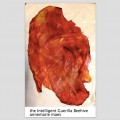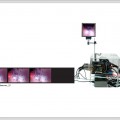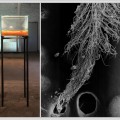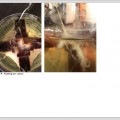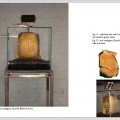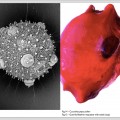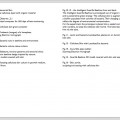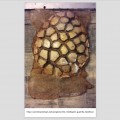The Intelligent Guerilla Beehive is a bio-art installation on the edge of art and science. It evokes issues of sustainability and biodiversity, giving viewers an artistic experience of my ongoing research related to the disappearance of the honeybee.
Bees are bio-indicators. They reflect the health of their surrounding ecosystem as well as the cumulative effects of different pollutants. In many industrialized nations bee colonies are now threatened. Pesticides and parasites are among the main factors, but equally worrisome is air pollution and the compromised state of the bees’ foraging fields.
The Intelligent Guerilla Beehive is a radically new beehive designed for urban environments, offering a shelter to swarming bee colonies, and thus supporting pollination by the bees and protecting the biodiversity of their foraging fields. It has also been a starting point for exploring possible futures through artistic research on materials science and biotechnology.
Navigating between a blueprint and a proof of concept, the Intelligent Guerilla Beehive is an artifact for the future, a fragment of a world to come. It tackles a new challenging application domain where a collaboration between human and non-human actors is necessary to maintain the resilience of the system.
The Laboratory for Form and Matter – an Innovation Lab where I research raw materials collected and produced by the bees- is the follow-up of my former fieldwork carried out in The Bee Laboratory. With custom-made observation beehives, augmented with monitoring technology, I have collected huge datasets on bee behavior and analyzed them using deep-learning algorithms in cooperation with researchers from the Artificial Intelligence Lab of the University of Brussels (VUB).
In my lab I work with a range of organic components, including propolis and chitine, and with living systems, such as fungi and bacteria, to help Nature grow fabrics. I research how these biofabrics can be supplemented through embedded electronics and how more sensorial qualities can be implemented in the membranes via living technology.
The Sensorial Skin –the outer membrane of the Intelligent Guerilla Beehive – is a smart fabric that integrates a mix of organic and electronic elements for sensing and actuating, for computation and for communication. Bacteria living in the upper cellulose skin act as biosensors. When they sense a specific degree of pollution, they are changing colors and making patterns that reflect the environmental threats. The double-sided skin, waxed at one side and covered with a pattern of porous stomata at the other side, is also giving room to beneficial bacteria to attack the bees’ natural enemy the Varroa destructor mite.
The Intelligent Guerilla Beehive is a speculative research project that combines in a radical way smart materials, biomimetic forms and biotechnology. It is inspired by the intelligence, complexity and self-organisation of bee colonies as Super Organisms.
[left] Infrared filming of a bee swarm starting to build a new nest.
[right] Split-screen comparison between 2 days of bee monitoring with different sensors inside/outside the beehive. The 2 videos (left and right) display a processing over 24 hours of data collected with the same sensors on different days of the bee-season. Sensors are: microphones inside the beehive (different parameters as amplitude, brightness, noise,…), temperature (inside/outside), regular filming of the flighthole (bee activity outside), infra red filming (bee activity inside). The activity of the bee colony is represented by particles which are starting to swirl once a tresshold (of the bee activity at the flighthole) is exceeded. On top of the video the day of the year, as well as the time and the minimum and maximum outside temperature are displayed.
bio’s
Anne Marie Maes (Be) is an artist and a researcher. Her work incorporates sculpture, photography, video, installation and public participation. Her research practice combines art and science with a strong interest for DIY technologies and digital fabrication. Her installations and long term projects – such as the Transparent Beehive, Urban Corridors or the Politics of Change – use a range of biological, digital and traditional media, including live organisms.
The findings of her research are materialized in techno-organic objects that tell factual/fictional stories; in artifacts that are a combination of digital fabrication and craftsmanship; in installations that reflect both the problem and the (possible) solution, in multispecies collaborations, in polymorphic forms and models created by ecodata. She is fascinated in the processes by which nature creates form: how bees self-organize into swarms, how plants grow and form geometric patterns, how bacteria and yeast cells collectively create material surfaces forming biofabrics. She observes and analyzes these processes, isolates them or causes them to appear in artificial conditions. She makes use of technological mediation to search for new forms of communication with the natural world, to make the invisible visible.
Anne Marie Maes is the founding director of the Urban Bee Lab and has for decades been a recognized leader pioneering art-science projects in Belgium, using highly original ways to bring out hidden structures in nature by constructing original technological methods to probe the living world and by translating that in artistic creations through sonification, visualization, sculptures, large-scale long-term installations, workshops, lectures and books.
She has a strong international profile, having exhibited (amongst others) at Bozar in Brussels, Koç University Gallery in Istanbul, Borges Center in Buenos Aires, Bozar in Brussels, Arsenals Museum in Riga, Skolska Gallery in Prague, the Institute of Evolutionary Biology in Barcelona, the Designmuseum in Mons and the Wissenschaftskolleg in Berlin.
Núria Conde-Pueyo (Es) is a post-doctoral researcher at Complex Systems Laboratory at Universitat Pompeu Fabra (UPF) in the PRBB. She holds a major in Biology and a engineering in informatics and performed her research thesis about Biocomputation, that it is at the interface of both fields. Nuria eventually teaches biology for architects, artist and designers of IAAC, Elisava or Massana universities. She is a founder member of the DIYBioBcn, the first biohacking group of Spain.
Anastasia Pistofidou (Gr) is a Greek Architect currently working at Fab Lab Barcelona/IAAC. She developed a personal applied research line on textiles, soft architectures and innovative materials : http://fabtextiles.org. Experimenting with new materials and processes, combining digital fabrication techniques and crafts, her work is demonstrating how new technologies can shift the massive consumption of fast fashion to a customised, personal and local fabrication applied on education and every day life.
Credits:
Artist, concept, research, materials research, design & fabrication: AnneMarie Maes
Supervision of bacterial experiments: Nuria Conde Pueyo
Digital modeling: Joeri Bultheel
Supervision of digital fabrication: Anastasia Pistofidou
Support received from the art laboratory OKNO (BE), Fablab Barcelona (IAAC, ES) Made@EU (EU grant via IAAC), Green Fablab (IAAC, ES), JRC-Joint Research Center EU (sections Science and Technology/citizen science and Public Health and Safety) (lspra, IT), Ministerie van Cultuur van de Vlaamse Gemeenschap (BE)

